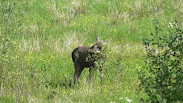Biograph The company was started by William Kennedy Dickson, an inventor at Thomas Edison's laboratory who helped pioneer the technology of capturing moving images on film. Dickson left Edison in April 1895, joining with inventors Herman Casler, Henry Marvin and businessman Elias Koopman to incorporate the American Mutoscope Company in New Jersey in December 1895. The firm manufactured the Mutoscope, and made flip-card movies for it, as a rival to Edison’s Kinetoscope for individual “peep shows”, making the company Edison’s chief competitor in the nickelodeon market. In the summer of 1896 the Biograph projector was released, offering superior image quality to Edison’s Vitascope projector. The company soon became a leader in the film industry, with distribution and production subsidiaries around the world including the British Mutoscope Company. In 1899 it changed its name to the American Mutoscope and Biograph Company, and in 1909 to simply the Biograph Company.
The first studio was located on the roof of 841 Broadway at 13th Street in Manhattan, known then as the Hackett Carhart Building and today as the Roosevelt Building. It was at this location that D. W. Griffith began as a director, and quickly became the studio's focus.



















